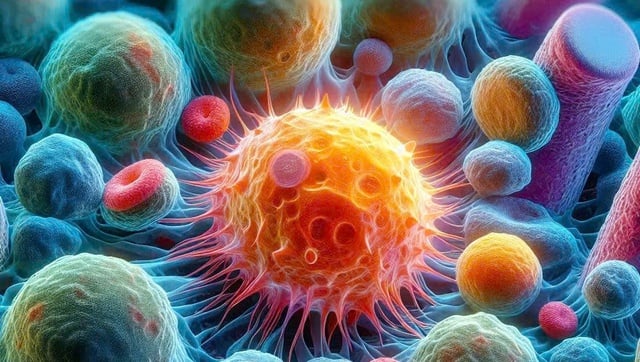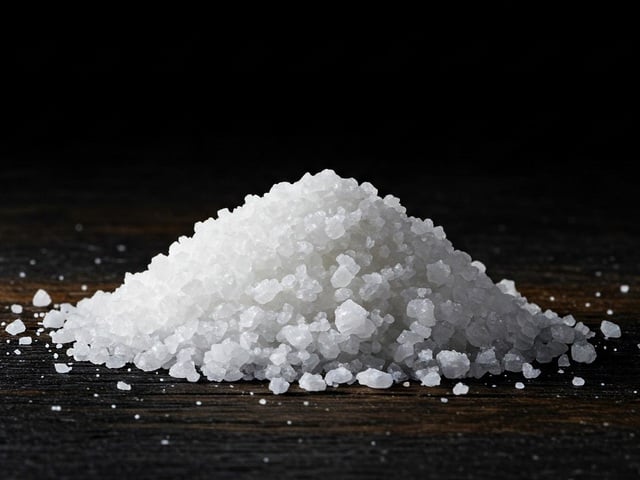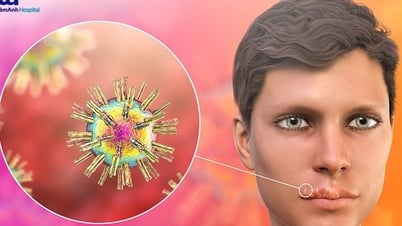Starting the day with health news , readers can also read more articles: Discovering the best exercise for the elderly to prevent diabetes; Eating at this time can cause significant weight gain ; Eating too much or too little salt is not good...
Discovered fruit is 'cancer nemesis'
In a new study recently presented at the FAPESP Scientific Conference held in Germany, researchers discovered the anti-cancer power of two familiar fruits that many people use every day.
Researchers from the University of São Paulo affiliated with the FoRC Research Center specializing in Food Science and Nutrition of Brazil, evaluated the biological effects of pectin on health.

Pectin, found in abundance in papaya, passion fruit and citrus fruits, is known for its ability to reduce many chronic diseases, especially its anti-tumor properties.
Photo: AI
Pectin - a soluble fiber found in papaya, passion fruit and citrus fruits - is known for its ability to reduce many chronic diseases, especially its anti-tumor properties. Therefore, the authors focused their research on papaya and passion fruit.
The results demonstrated strong potential of pectin in papaya and passion fruit in fighting diseases, emphasizing the development of methods to enhance their therapeutic efficacy.
The findings highlight the significant therapeutic benefits of phytonutrients, particularly their ability to aid in cancer treatment. The next part of this article will be available on the health page on April 6 .
Salt: Eating too much is dangerous, eating too little is also not good
Eating too much salt can be dangerous for your health, especially your heart. A diet high in salt increases your risk of heart attack, stroke, and even kidney disease. However, eating too little can also be dangerous.
To ensure good health, people should eat salt in moderation. The World Health Organization (WHO) recommends eating no more than 5 grams of salt per day, while the American Heart Association says the ideal level is about 3.8 grams of salt per day.

Salt is rich in sodium, which plays a very important role in health.
PHOTO: AI
If you eat too little salt, your body may experience the following problems:
Electrolyte imbalance. Electrolytes such as sodium, potassium, calcium, and magnesium are electrically charged minerals that play an essential role in vital functions such as nerve transmission, muscle contraction, and fluid balance in the body. Electrolyte imbalances disrupt these processes, leading to a variety of complications.
Salt is rich in sodium. Sodium is especially important in regulating the amount of water in and around cells. When sodium is deficient, cells can swell, leading to symptoms ranging from mild nausea and headaches to severe seizures and coma.
Eating less salt can cause hyponatremia. Hyponatremia is a condition in which the sodium concentration in the blood is lower than normal, causing water to rush into the cells and cause them to swell. This is especially dangerous when the brain cells swell. The skull does not have space to expand, which can easily lead to neurological disorders such as confusion, seizures, and in severe cases, coma. The next content of this article will be on the health page on April 6 .
Discover the best exercises for older adults to prevent diabetes
Diabetes is one of the most common chronic metabolic disorders – with approximately 10% of the global population affected, with middle-aged and older people at higher risk.
Furthermore, diabetes increases the risk of many complications such as heart disease, stroke, high blood pressure and narrowing of blood vessels. Therefore, disease prevention is a major global public health concern.

People of middle age and older are at higher risk of diabetes
Photo: AI
Scientists from the University of Hong Kong conducted a large-scale epidemiological study to explore the potential health benefits of high muscle strength in preventing type 2 diabetes in genetically at-risk individuals.
The study used data from 141,848 participants from the UK Biobank. Participants were an average age of 56.6, had no diabetes at baseline, and were followed for more than seven years.
During follow-up, there were 4,743 new cases of diabetes.
The results, published in the medical journal BMC Medicine, found that higher muscle strength was associated with a 44% lower risk of diabetes, even in people with a genetic risk of developing the disease. Start your day with health news to read more about this article!
Source: https://thanhnien.vn/ngay-moi-voi-tin-tuc-suc-khoe-phat-hien-2-loai-trai-cay-phong-ung-thu-185250405232544521.htm


![[Photo] Readers line up to visit the photo exhibition and receive a special publication commemorating the 135th birthday of President Ho Chi Minh at Nhan Dan Newspaper](https://vphoto.vietnam.vn/thumb/1200x675/vietnam/resource/IMAGE/2025/5/17/85b3197fc6bd43e6a9ee4db15101005b)


![[Photo] More than 17,000 candidates participate in the 2025 SPT Competency Assessment Test of Hanoi National University of Education](https://vphoto.vietnam.vn/thumb/1200x675/vietnam/resource/IMAGE/2025/5/17/e538d9a1636c407cbb211b314e6303fd)

![[Photo] Prime Minister Pham Minh Chinh chairs meeting on science and technology development](https://vphoto.vietnam.vn/thumb/1200x675/vietnam/resource/IMAGE/2025/5/17/ae80dd74c384439789b12013c738a045)




















![[Photo] Nearly 3,000 students moved by stories about soldiers](https://vphoto.vietnam.vn/thumb/1200x675/vietnam/resource/IMAGE/2025/5/17/21da57c8241e42438b423eaa37215e0e)






































































Comment (0)